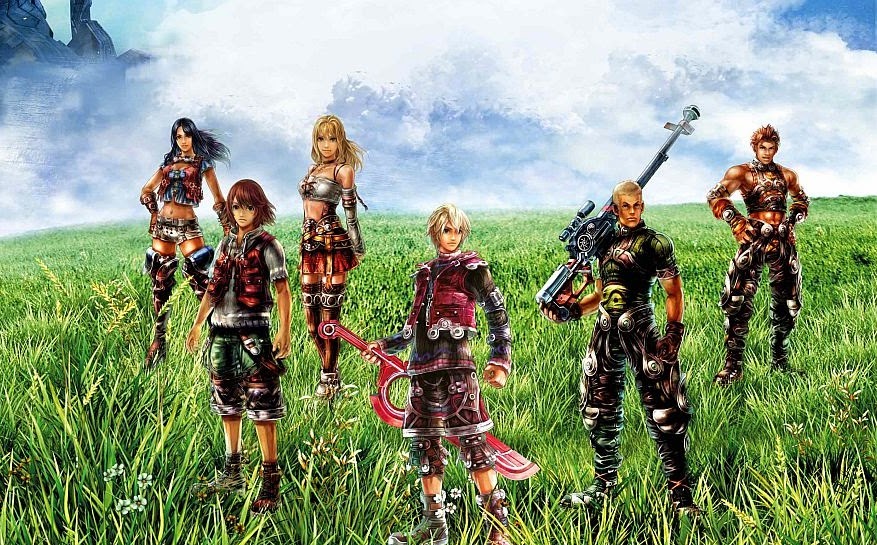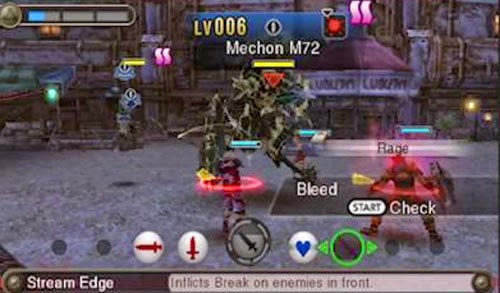Xenoblade Chronicles was certainly a popular game on the Nintendo Wii when it was released towards the end of that console’s life. As the premier JRPG on the system it never quite left the mindset of its many fans, even with the Wii now retired, and I find it amusing that a game that Nintendo of America resisted bringing to the west for so long would become the premier game to sell as an exclusive for the New Nintendo 3DS.
But that’s how life’s mysteries work, and now we’ve got a game that aimed to be as epic as the Wii’s limited hardware could handle, squashed into the tiny screens of the Nintendo 3DS. Before I get on with discussing the game, I’ll do something I rarely do and discuss the technical side of things. I like to think of myself as a fellow that places far more importance on narrative, theme, philosophy, meaning, and all that other good stuff, then telling people how much fun it is to press buttons. We’ll get on to the artsy stuff in a second, but in this instance I am compelled to make an exception to my usual modus operandi because holy heavens is Xenoblade ugly on the 3DS hardware.
With everything shrunk down into a screen size that it was never designed for, it’s difficult to see the fine details in the environment around your characters, and there is no better example to highlight what a problem this is than when you consider that important quest icons that appear above character’s heads are tiny little “!”s that too easily disappear into the background. Numerous times I ran around in circles because I was pointed to a spot on the minimap where there was meant to be a quest to follow, only to struggle to find the character I was meant to be talking to who would give me that quest.
Characters models are also poor. It’s been some time since I played the Wii original, but I don’t remember them having the sheer lack of detail that they do in the 3DS version. I don’t remember their mouths moving like Pac-Man’s when they talk. This lack of model detail doesn’t just mean that there is no reason to grind away enough cash to buy the swimwear costumes for the characters, either. Despite having already played the game, I really struggled to connect with the characters this time around, and that was because to my eyes they were not much more than people-ish shaped blobs that flapped about weirdly.
Other game developers, such as those behind the upcoming Hatsune Miku 3DS game, or those behind the Persona Q release from last year, have adopted big SD character heads on nendoroid-like bodies as almost a default when developing games on the Nintendo 3DS. At first I didn’t really understand why, but after playing the 3DS version of Conception II it started to make sense, and now after Xenoblade Chronicles 3D I realise clearly that the reason is very simple; big heads compensate for the low resolution of the 3DS screen, and allow players to look into the eyes of the characters. That, in turn, allows the developer to give those characters personality.
It’s also worth noting that I tested this game on the New Nintendo 3DS XL model. I shudder to think how it would work on the even smaller screen of the originally-sized model. I honestly suspect some sections would be utterly unplayable on those devices. Finally, on the most superficial level, this game offers a wide, open world to explore, and when viewed through such a small window, the majesty that the game works so hard to create is largely lost. This in turn means that Xenoblade Chronicles on the 3DS doesn’t have quite the same atmosphere that the original was so revered for.
But, putting aside all of that, if you’re able to grapple with the attempt to squash a mighty big square into a tiny little circle, Xenoblade Chronicles, the game, remains one of the most compelling and important narratives that the JRPG genre has produced.
What’s most fascinating about it is how it compares and contrasts to Mass Effect, of all games. At the request of Nintendo I unfortunately can’t go into the narrative as I would like to, because it would mean some sharp spoilers, but speaking in general terms; Mass Effect and Xenoblade are equally concerned with the relationship between synthetic and bionic life forms, and the implied conflict that should be inevitable between the two. Xenoblade’s mechanical life forms behave a little like Mass Effect’s Reapers; natural predators that hold biological life in check, though the narrower focus (this is a global, rather than interstellar, conflict) means that Xenoblade has a dynamic more like a small ecosystem with a mechanical tiger sitting as the apex predator, rather than a grand philosophical debate that encompasses all living things.
That’s not to say Xenoblade doesn’t have a philosophy of its own, for it certainly does. It’s hugely critical of authority and an aggressive advocate for communal living and support, with harmony being presented as those communities with which there is a flat on minimal leadership structures, and people instead appeal directly to one another for help and support. This contrasts in a fascinating manner with more common Japanese literature themes around duty, honour, sacrifice and nobility, and of course the despotic structures of the synthetic life forms. Because the narrative itself is linear, rather than Mass Effect’s branching conversation trees, players have less room to experiment with its themes, but the arguments that it puts forward are strong.
It’s also a game that works hard to build emotional gravitas through the narrative. Inter-character relationships are especially important, and littered throughout each environment are icons that allow characters to have “heart to heart” conversations with one another. These could be pulled straight from a soap opera in terms of the writing quality, but nevertheless reading through them provides the player with a better sense of character personality, which in turn helps to make the frequent death and destruction around them more weighty. It’s a little like a G-rated version of the sex scenes of Mass Effect, in terms of the impact that these little vignettes have on the overall experience of narrative.
The creativity with regards to the people, cultures, landscapes and enemy designs remain consistently strong from the start of the game right through to the end. Xenoblade Chronicles invites players to explore its wide landscapes by offering experience rewards for locating new areas, and even when not tied directly into the narrative, these brief bits of lore and odd locations provide a tantalising sense of something greater than the main narrative, and help to create a world with a greater sense of history and culture.
This setting is further built out with a wonderful soundtrack that loses nothing in the transition to handheld. Though the lack of a Japanese voice track is irritating, the orchestral pieces fit with the various environments with breathtaking precision, equally capable of lifting or crushing spirits based on what the narrative and environment call for at the time. When we talk about how a soundtrack could be used to enhance and build on a game’s setting and atmosphere, Xenoblade Chronicles is proof of that in motion.
As for how it plays; Xenoblade Chronicles is very much like an MMO. Players don’t directly control the attacks of their characters, but rather they select a target enemy, which the character will automatically attack. At the bottom of the screen is a row of icons, from which special attacks can be selected. Some attacks require characters to be behind or on the side of an opponent, so there is a constant need to move around the battlefield to find and exploit enemy weaknesses. This is a fast-paced battle system, which makes it a little overwhelming to try and aid other characters with healing and buffs while concentrating on the enemies (especially because it’s hard to track anything when the screen is this small), but it’s enjoyable nonetheless, and boss battles are large and challenging enough that there’s real satisfaction for progressing through them.
Xenoblade Chronicles 3D doesn’t really belong on the Nintendo 3DS. In fact, Nintendo would have been better off going the other way and doing a “HD” version for the Wii U in the lead up to the next Monolith Software release on that console. But, that aside, this is a classic game, and having that experience on the go is not a bad bonus reason to purchase the New Nintendo 3DS.
– Matt S.
Editor-in-Chief
Find me on Twitter: @digitallydownld




.png)
.jpg)





